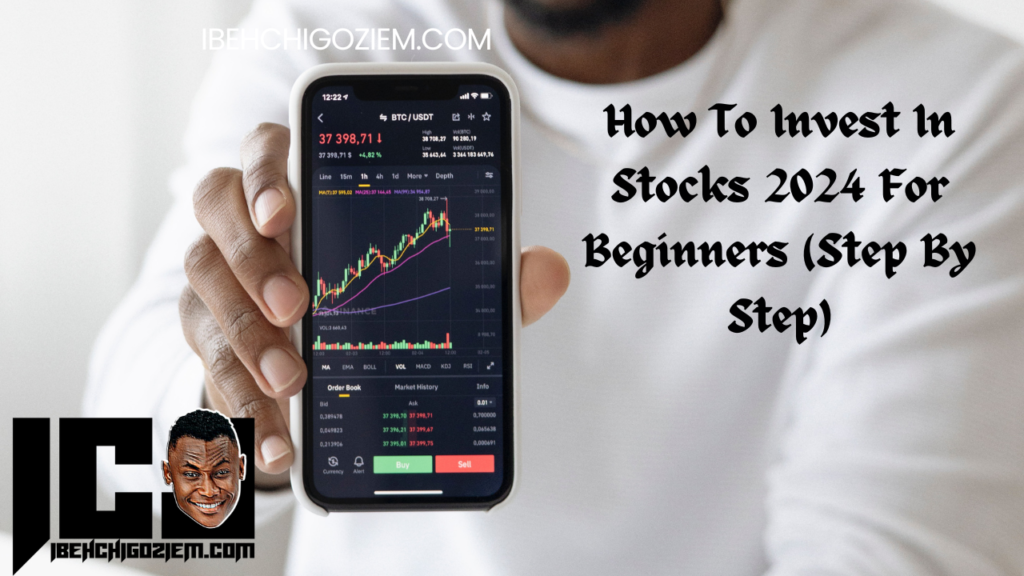How To Invest In Stocks 2024 For Beginners (Step By Step)
If the thought of investing in the stock market scares you, you are not alone. People without a strong background in finance are either startled by stories of normal investors losing even 70% of the value of their portfolios or they fall for “hot recommendations” that promise huge rewards but are rarely profitable.
Even while stock market trading entails risk, when done with discipline, it is one of the most efficient ways to build one’s net worth. While the normal individual keeps most of their net worth in their home, the wealthy and extremely wealthy frequently invest the majority of their fortune in equities.
ALSO, READ Top 9 Benefits Of Investing In Stocks (2024)
I’ve covered all you need to know about stock investing for beginners in 2024 in great detail in this article.
What Exactly Is A Stock?
A stock usually referred to as equity, is a type of investment that denotes ownership in a portion of the issuing company. Shares, also known as units of stock, entitle their owners to a share of the company’s assets and income in proportion to the number of shares they possess.
Meaning if a company has 100,000 outstanding shares and you own 2,000 shares, it means you own 2% of the company.
How Is Money Made From Stocks?
Dividends and capital gains are the two ways that stock ownership can generate income. Dividends are payments made in cash from a company’s profits. Stockholders will get $5 for each of their 1,000 outstanding shares if the corporation declares a $5,000 dividend and there are 1,000 shares outstanding.
On the other hand, the rise in share price is known as capital appreciation or gain. If you buy a share of stock for $100 and it goes on to become worth $110 when you sell it, you make $10.
What is the Stock Market?
The phrase “stock market” describes several marketplaces where shares of publicly traded firms can be purchased and sold. Such financial transactions take place on official exchanges and in over-the-counter (OTC) markets that adhere to a predetermined set of rules.
The terms “stock exchange” and “stock market” are frequently used interchangeably. However, traders purchase and sell stocks on one or more of the stock exchanges that make up the broader stock market. The New York Stock Exchange (NYSE) and the Nasdaq are two of the most significant U.S. stock exchanges.
Stock buyers and sellers can connect, communicate, and conduct business on the stock market. The markets provide price discovery for stock in firms and act as a gauge for the state of the national economy. Because market participants compete in an open market, buyers and sellers may be sure that they will receive a fair price, a high level of liquidity, and transparency.
It’s crucial to realize that businesses with stock market listings don’t frequently buy and sell their shares. Companies may repurchase shares of stock or issue new ones.
Therefore, when you purchase stock on the stock market, you do not do it from the company but rather from another shareholder who already owns the stock. Similar to buying shares, selling shares involves selling them to a different investor rather than the corporation.
How Are The Prices of Shares Determined?
There are various methods for determining share prices on a stock exchange. Most frequently, bids and offers to buy or sell are made via an auction process where buyers and sellers can participate. An offer (or ask) is the price at which someone wants to sell, and a bid is the price at which someone wants to purchase. A trade is made when the bid and asks match.
Millions of investors and traders make up the total market, and each of them may have a different opinion regarding the worth of a particular stock and, consequently, the price at which they are willing to purchase or sell it.
Over a trading day, the thousands of transactions that take place as these traders and investors turn their intentions into deeds by purchasing and/or selling a stock generate minute-by-minute gyrations it.
By connecting buyers and sellers of equities, a stock exchange offers a platform where such trading can be conveniently carried out. The typical person would require a stockbroker to gain access to these exchanges. This stockbroker serves as a go-between for the buyer and vendor. The most frequent way to obtain a stockbroker is to open an account with a reputable retail broker.
How To Invest In Stocks In 2024 For Beginners (Step By Step)

1. Decide on Which Type of Investor You Are
To invest in stocks the first thing you need to do is to open a brokerage account, which is an investment account used to buy and sell securities including stocks, bonds, mutual funds, and ETFs.
There are many authorized brokerage companies where you can open an account, ranging from more expensive full-service stockbrokers to affordable online or discount brokers.
Full-service brokers offer the full range of conventional brokerage services, including financial guidance for retirement, healthcare, and all other aspects of money management, as the name suggests.
ALSO, READ How To Save And Invest Money As A Salary Earner (2024)
These are the more established stockbrokers who will take the time to learn about your financial situation and personal life. They will take into consideration variables like marital status, way of life, personality, risk tolerance, age (time horizon), income, assets, debts, and more.
These full-service brokers will learn as much about you as they can so that they can assist you in creating a long-term financial plan. The term “full service” refers to the fact that these brokers can assist you with all of your financial needs, including those related to investments, as well as estate planning, tax planning, planning for retirement, budgeting, and every other form of financial guidance.
They are for investors who want everything in one bundle and can assist you in managing all of your financial demands both now and in the future.
How To Invest In Stocks In 2024 For Beginners (Step By Step)
Full-service brokers charge more fees than cheap brokers, but the benefits of working with a real, live financial advisor may outweigh the higher prices. Currently, accounts can be opened for as low as $1,000. If you want this route, all you need is to find a reliable broker and you’re done.
On the other hand, online/discount brokers are essentially just order takers and do not offer any form of investing advice. Here you are actively involved in the investment process. Since there often isn’t an office to go to and no registered financial consultants to assist you, they are significantly less expensive than full-service brokers.
You can normally start an account online with little to no money, and costs are typically determined on a per-transaction basis. Once you’ve opened an account with an online broker, you may typically buy and sell stocks right away by logging into your account on the broker’s website.
Keep in mind that you are completely on your own to handle your assets because these types of brokers offer zero financial advice, stock suggestions, or other forms of investment assistance. Technical support is typically the only help you will get.
Online (discount) brokers do provide connections to, and other resources on, investing that may be helpful. This is the route to go if you think your understanding of investing is sufficient to manage your own finances, or if you don’t know anything at all about investments but are eager to learn.
2. Research The Stocks And Companies Available

The process of choosing stocks can begin once your brokerage account has been created and funded. Investigating businesses you are already familiar with from past customer interactions is the next step to investing in stocks.
Don’t become overwhelmed by the flood of data and real-time market gyrations while you perform your study. Keep your goal straightforward— you are looking for businesses that you would like to invest in so it’s time to perform some investigation when you’ve determined which businesses these are.
Start with the annual report of the business, in particular the management’s message to shareholders. The letter will offer you a broad overview of the company’s current situation and provide the report’s data with some context.
After that, the majority of the data and analytical tools you require to assess the company will be accessible on your broker’s website, including SEC filings, transcripts of conference calls, quarterly earnings reports, and recent headlines. The majority of internet brokers also offer training sessions on how to utilize their products and even fundamental courses on stock selection.
3. Determine How Much You Will Like To Invest In Stocks

There should be no pressure placed on you to purchase a specific quantity of shares or to include a stock in your whole portfolio at once. To get your feet wet, think about beginning with paper trading by utilizing a stock market simulator.
Paper trading allows you to practice buying and selling stocks using fake money until you are more comfortable investing in stocks. Or you can start small if you’re willing to invest actual money. You may buy just one share to get a sense of what it’s like to own individual equities and to determine whether you have the stamina to weather the tough times with little loss of sleep.
As you develop your shareholder identity, you may gradually increase your position. Fractional shares, a relatively recent provision from online brokers that allows you to acquire a portion of a stock instead of the complete share, may also be something new stock buyers should take into consideration.
That basically indicates that you can invest considerably less money to buy expensive stocks. Brokers that provide fractional shares include Charles Schwab, Robinhood, and SoFi Active Investing.
Numerous brokerages now provide a tool for converting dollar amounts to shares. This is useful if you want to know how many shares you could purchase with a specific investment amount.
4. Select And A Place An Order
The next step in investing in stocks is understanding and placing an order. There are basically two types of orders you should be concerned with as a beginner: market order and limit order.
By placing a market order, you promise to purchase or sell the stock at the best current market rate. Unless you’re going to acquire a million shares, your order will be executed right away and fully filled because a market order places no price limits on the trade.
You should not be bothered if the amount you pay, or receive when selling, differs from the figure you saw a few moments before placing the order because throughout the day, bid and ask prices are constantly changing.
The best time to utilize a market order is when buying large, stable blue-chip stocks rather than smaller, more volatile businesses because they don’t typically experience large price swings. For buy-and-hold investors, a market order is an optimal option since they value the full execution of the trade over minute price variations.
When the exchanges have ended for the day and you put a market order at “after hours,” the order will be filled at the current price whenever the exchanges reopen for trading.
On the other hand, there’s a limit order. You have more influence over the price for which your deal is executed with a limited order. Your limit order instructs your broker to hold off and only execute your order when the price falls to a certain level, such as $125 per share if you believe that’s how much you value a stock selling at $160 per share.
Limit orders are a useful tool for traders buying and selling smaller firm stocks since, based on investor activity, these equities frequently have more fluctuations. Investing in them is also an excellent idea when there is short-term market instability or when stock price matters more than order fulfilment.
There is no assurance that a limit order will be filled completely, partially, or even at all, but it guarantees the price you will receive if the order is completed. Limit orders can only be placed on a first-come, first-served basis, once all market orders have been filled, and if the stock remains at your set price for a duration necessary for the broker to execute the trade.
You may pay higher commissions for limit orders than for market orders. Limit orders that cannot be filled entirely at once or within one trading day may nevertheless be filled over additional days, with transaction costs applied each time a deal is executed.
5. Continue To Increase Your Literacy And Monitor Your Stocks

It’d be exciting if your first stock purchase ushers in a lifetime of prosperous investing. But if circumstances get challenging, keep in mind that every investor experiences challenging times.
Keeping your perspective and focusing on the things you can control can help you succeed in the long run. Market swings are not one of them. However, you have some things under your control.
Once you are familiar with the stock purchase process, spend some time learning about other areas of the investment industry. What part do mutual funds plan to play in your investment story? Have you opened a brokerage account in addition to a retirement account, such as an IRA? Opening a brokerage account and buying some stocks is the first step in your investment journey, but this is just the start.
Conclusion
When investing in stocks as a novice, it’s important to keep in mind several key general principles, such as choosing an easy-to-use broker, researching the stocks you’re considering, figuring out how much you’d want to invest, choosing the order type that works best for you, and monitoring your stocks. If you follow these instructions, you’ll be well on your way to building a stock portfolio like a pro.


